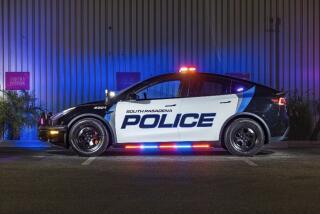Long Legs of the Law : Mounted police units are valued for crowd control and park patrols--but training takes more than horse sense
- Share via
ANAHEIM — Atop his palomino, Buddy, Police Sgt. Paul Gallagher rode up to the giant blue tarp, a bouquet of colored balloons attached, that was draped over the arena rail.
Buddy repeatedly spooked away, terrified by the unfamiliar objects.
But by the end of the training session Monday morning, the horse calmed down as he became more familiar with the flapping tarp, balloons and some glowing red road flares.
That was the goal for Gallagher and the other officers in the Police Department’s mounted enforcement unit: to get their four-legged partners accustomed to situations and objects they may encounter while patrolling city parks, neighborhoods and special events.
“It’s important that we train together on a routine basis, because we get better confidence in what our horse can do and what other officers we ride with can do,” said Capt. Marc Hedgpeth, who rides in the mounted unit with his appaloosa, Kadie.
“We don’t put a horse and rider out [on the street] until they have the sufficient skills,” he said. “You can’t afford to have a horse that is uncontrollable.”
Anaheim’s police equestrian unit began in May 1995 on a trial basis with two horses and has grown to 10 horses and officers, all of whom have regular duties and volunteer for the part-time unit. The Santa Ana Police Department and the Orange County Sheriff’s Department also have mounted patrol units.
Just since last year, according to Gallagher, 16 law enforcement agencies in the state have started mounted units.
Orange County sheriff’s spokesman Lt. Ron Wilkerson said the department owns seven horses, and 30 to 40 people volunteer in the unit.
Mounted units are used for a variety of duties, including crowd control and searches for lost people.
Disneyland also began using two mounted units in July to patrol the parking lot and as a public relations tool to greet guests.
The park plans to buy four more horses for the program, said Debbie Sligh, who oversees Disneyland’s animals.
Anaheim’s horses are used to control crowds at events at the Pond and to patrol parks and high-crime neighborhoods for drug sales and gang activity.
Officers on horseback are highly visible, more so than their counterparts on foot, bicycle or in patrol cars, Hedgpeth said.
“When you’re sitting on a horse you can look over things,” Hedgpeth said. “You look over rows and rows of cars. In a patrol car or on foot, you can’t see that.”
On the saddle, officers can also go where vehicles can’t, Hedgpeth said.
Gallagher also said that using horses in law enforcement is not only a deterrent to crime, but also good public relations.
“Often a police officer seems so unapproachable, but an officer on horseback seems to break down those barriers,” he said. “People want to talk to you and pet the horse.”
The Anaheim officers use their own horses and pay for their upkeep, such as boarding costs and veterinary bills. The city provides liability coverage should the horse get injured while on duty and pays for equipment, including riding pants and western-style hats for officers and reflector boots for the horses’ legs.
Unit members train together once a month, and officers work on problem areas with their horses on their own time, said Officer Frank Harris, the unit’s instructor. Officers also complete a 40-hour course with the state Peace Officer Standards and Training.
The “sensory” training session Monday at Rancho del Rio Stables included encounters with objects such as an umbrella, a stuffed purple dinosaur and a plastic bag filled with coffee cans.
Officers practiced sidestepping across cones, because horses often must walk across broken glass or other hazards. They also practiced hurdling small fences and walked between barrels.
“The mentality as far as training is not to scare the horse and leave him in a frightened state, but work with him and let him know it isn’t going to scare him,” Harris said.
Officers in the unit volunteer for the duty because it is a chance to use their horsemanship skills on the job.
“It gives us the opportunity to combine our love for horses with our occupation,” Hedgpeth said.
More to Read
Sign up for Essential California
The most important California stories and recommendations in your inbox every morning.
You may occasionally receive promotional content from the Los Angeles Times.













